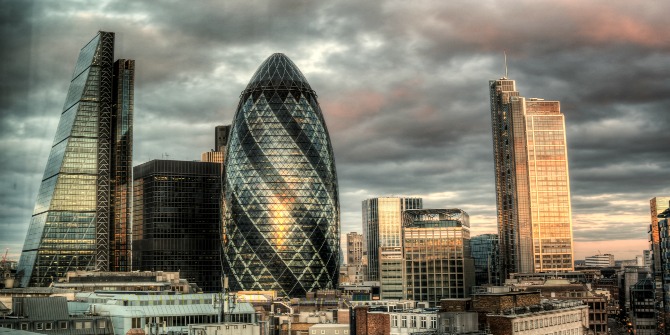 Following research by the New Policy Institute (NPI), Gavin Kelly looks at aspects of London’s poverty profile since the recession. He writes that, despite the gloom of the housing market and the rise in in-work poverty, the capital’s schools have made astonishing improvements, especially in regard to the achievements of deprived children, while many new jobs have been created. He argues it is now up to policy-makers to capitalise on these gains and ensure more equal access to high paying jobs.
Following research by the New Policy Institute (NPI), Gavin Kelly looks at aspects of London’s poverty profile since the recession. He writes that, despite the gloom of the housing market and the rise in in-work poverty, the capital’s schools have made astonishing improvements, especially in regard to the achievements of deprived children, while many new jobs have been created. He argues it is now up to policy-makers to capitalise on these gains and ensure more equal access to high paying jobs.
What is the outlook for poverty and opportunity in London? Depending on the media you consume you might have the impression that London, undisturbed by the financial crisis, is a hipster-driven economy powered by prodigious rates of job creation and business start-ups that is extending economic opportunity into every corner of the city. Alternatively you could live on a diet of news pieces telling you that our capital is defined by neo-Dickensian inequalities, rogue landlords, creaking infrastructure, and a top-end housing market that serves as little more than a global reserve currency for international criminals and the super-rich.
If you want a sober guide to navigate you through the reality of poverty and opportunity in today’s London then the annual poverty profile produced by the think-tank NPI (supported by Trust for London) is the place to look. It’s meticulously compiled and now in its sixth year providing us with an evolving sense of how the nature of disadvantage is shifting over time — from inner city to suburb, and East to West.
The headlines that came out of it were, not surprisingly, gloomy and centred around the continued rise in working-poverty that the capital, like the rest of the country, has experienced. There’s no shortage of depressing findings in its 100 pages (some very timely, for instance, 40 per cent of all children in boroughs like Newham, Hackney and Brent are about to be on the sharp end of deep cuts in tax credits). But read through it and a more nuanced picture emerges. For me it’s a tale of the good, the bad and the ugly (though not in that order).
Let’s start with the source of so much of London’s poverty challenge and by far its ugliest problem: housing. It will surprise few that before housing costs are considered, London has low rates of poverty; yet after they are factored in the city becomes the nation’s poverty capital.
A lack of other options means that London’s poor are increasingly private renters, outnumbering either social-renters or owners (a reversal from a decade ago). And rents are now more than double the English average, climbing 19 per cent over the last 5 years. There are now more working housing benefit claimants in private rented accommodation then there are workless. As Resolution Foundation research has shown, one in five working London households who rent in the private sector pass over half of all their disposable income to their landlord (nationally the figure is 12 per cent). In a multitude of different ways the new report confirms that the cost of housing results in an awful lot of Londoners living dangerously close to the edge. Put this alongside London’s failure to get anywhere close to meeting its affordable housing targets and we already know that next year’s report will conclude with more of the same.
The rise of working poverty is reinforced by what we can fairly describe as some ‘bad’ trends in Londoners’ pay. Contrary to many popular notions about London riding out the down-turn relatively unscathed, it has actually experienced the largest pay squeeze in Britain. Using the standard measure (hourly pay) there was an 11 per cent fall for the typical worker and 10 per cent for those at the bottom from the crisis through to 2014.That’s bad enough. But if we look at weekly earnings — a closer relation to what’s been happening to living standards — then the Resolution Foundation estimate there has been a truly eye-watering 20 per cent fall for London’s lowest earners (yes, you read that right).

That said, trends in pay are only half of the labour market story — when we look at employment things are much sunnier. London was the first part of the UK to surpass its pre-crisis employment level and it has now ditched its reputation as being the region with the highest rate of long-term unemployment. Take a longer term view and we can see that since the mid-1990s London’s rates of worklessness have more than halved, as has the unemployment rate in inner London.
So if that is the ugly and (partially) bad part, what is the good news? It is confirmation of an existing trend that is increasingly noted but still needs to be shouted about: the astonishing improvement in London’s schools, particularly for the poor. This is a sustained finding; not a short-term blip. In 2002 22 per cent of children in inner London on free school meals got five or more good GCSEs (including Maths and English). By 2013 this had leapt to 48 per cent (outside London the change was 17 per cent to 26 per cent). These are spectacular advances — I’ve never seen anything like them in the UK. If you are a child from a deprived family hoping for the best chance of a decent education then fingers crossed you are raised in London not Manchester, Birmingham, Glasgow or Bristol. That’s a big change.
Some argue that, though accurate, this has little to do with anything that happens in London’s schools: it’s simply demographics, a reflection of the fast shifting ethnic and socio-economic make-up of the city. But new research from the IFS, LSE and others disputes this, estimating it only accounts for under half of the gains in standards at age 11. London’s poorest kids don’t start off ahead of their counterparts elsewhere, they just progress further.
Which tells us something powerful, and slightly mysterious, has happened inside London’s schools. One likely factor was Labour’s early primary school reforms to literacy and numeracy (the biggest gains in standards occurred in primaries; though Chris Cook, no slouch on these matters, thinks the methodology adopted may be a bit unfair to London secondaries). These gains seem to have been reinforced by high-voltage reforms of secondary schools — the London Challenge, the early and extensive use of Academies, nurturing new school leaders and the introduction of Teach First. It’s fair to say that we don’t yet fully understand which of these ingredients had the biggest impact; but we do know that something special happened.
Just because there is a smaller gap between London’s poor children and the rest compared to else-where, it doesn’t of course mean that the remaining gap isn’t shamefully large (though credit to the likes of Tower Hamlets and Islington where the differences between FSM kids and the rest are now relatively modest). Nor, importantly, do we really know what will happen to the London Challenge generation when they fully complete their journey through post-compulsory education into the jobs market.
But we do know that London has created a formidable number of high-end jobs (as well as low-end) throughout the downturn at exactly the same time it’s been making these strides in schools, especially for the poorest. If the institutions of this city — educational, business, governmental — can’t find a way of mobilising to translate those gains into more equal access to the decent and high paying roles that the city is bound to create, it would be a grotesque abdication of policy and civic leadership.
All of this is a vital back drop to May’s mayoral election. The severity of some of London’s challenges should help force the candidates out of comfort-zone positions. As London becomes a majority renter city it isn’t electorally viable to simply mouth platitudes about helping those who aspire to own to get on the ladder. Some passing warm words about the London living wage aren’t likely to cut it either. It’s true that mayoral powers over some of these key issues are relatively slim and there is a good case to be made for bulking them up. But there is a huge amount that a pioneering yet delivery-focussed Mayor could do to improve the supply of affordable housing, spread the living wage, and improve the transition from school to college to work. Sadiq and Zac, over to you.
___
Please note: this article was originally published on Gavin’s personal blog and is reposted here with kind permission. It is based on a talk given at the launch of London’s annual poverty profile at the Museum of London.
 Gavin Kelly is the CEO of the Resolution Trust, and the former Director of the Resolution Foundation. He tweets as @GavinJKelly1
Gavin Kelly is the CEO of the Resolution Trust, and the former Director of the Resolution Foundation. He tweets as @GavinJKelly1







